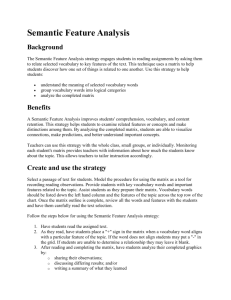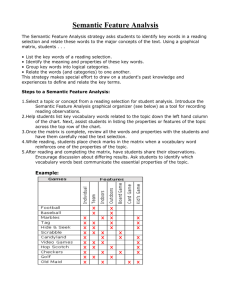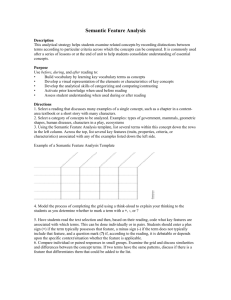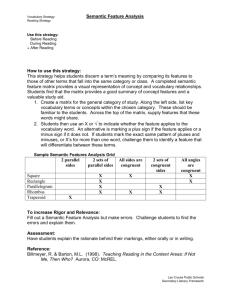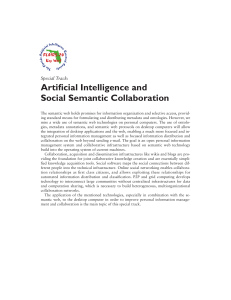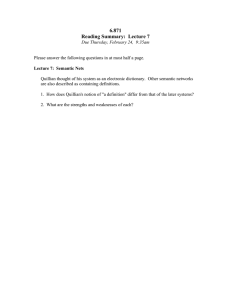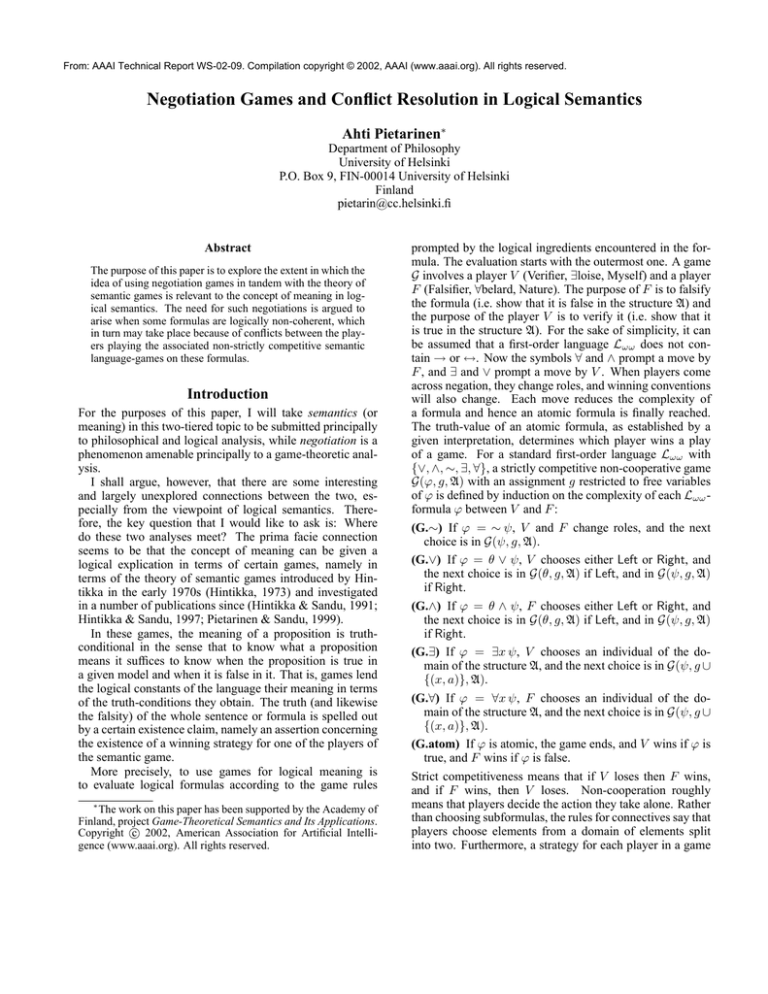
From: AAAI Technical Report WS-02-09. Compilation copyright © 2002, AAAI (www.aaai.org). All rights reserved.
Negotiation Games and Conflict Resolution in Logical Semantics
Ahti Pietarinen∗
Department of Philosophy
University of Helsinki
P.O. Box 9, FIN-00014 University of Helsinki
Finland
pietarin@cc.helsinki.fi
Abstract
The purpose of this paper is to explore the extent in which the
idea of using negotiation games in tandem with the theory of
semantic games is relevant to the concept of meaning in logical semantics. The need for such negotiations is argued to
arise when some formulas are logically non-coherent, which
in turn may take place because of conflicts between the players playing the associated non-strictly competitive semantic
language-games on these formulas.
Introduction
For the purposes of this paper, I will take semantics (or
meaning) in this two-tiered topic to be submitted principally
to philosophical and logical analysis, while negotiation is a
phenomenon amenable principally to a game-theoretic analysis.
I shall argue, however, that there are some interesting
and largely unexplored connections between the two, especially from the viewpoint of logical semantics. Therefore, the key question that I would like to ask is: Where
do these two analyses meet? The prima facie connection
seems to be that the concept of meaning can be given a
logical explication in terms of certain games, namely in
terms of the theory of semantic games introduced by Hintikka in the early 1970s (Hintikka, 1973) and investigated
in a number of publications since (Hintikka & Sandu, 1991;
Hintikka & Sandu, 1997; Pietarinen & Sandu, 1999).
In these games, the meaning of a proposition is truthconditional in the sense that to know what a proposition
means it suffices to know when the proposition is true in
a given model and when it is false in it. That is, games lend
the logical constants of the language their meaning in terms
of the truth-conditions they obtain. The truth (and likewise
the falsity) of the whole sentence or formula is spelled out
by a certain existence claim, namely an assertion concerning
the existence of a winning strategy for one of the players of
the semantic game.
More precisely, to use games for logical meaning is
to evaluate logical formulas according to the game rules
∗
The work on this paper has been supported by the Academy of
Finland, project Game-Theoretical Semantics and Its Applications.
c 2002, American Association for Artificial IntelliCopyright gence (www.aaai.org). All rights reserved.
prompted by the logical ingredients encountered in the formula. The evaluation starts with the outermost one. A game
G involves a player V (Verifier, ∃loise, Myself) and a player
F (Falsifier, ∀belard, Nature). The purpose of F is to falsify
the formula (i.e. show that it is false in the structure A) and
the purpose of the player V is to verify it (i.e. show that it
is true in the structure A). For the sake of simplicity, it can
be assumed that a first-order language Lωω does not contain → or ↔. Now the symbols ∀ and ∧ prompt a move by
F , and ∃ and ∨ prompt a move by V . When players come
across negation, they change roles, and winning conventions
will also change. Each move reduces the complexity of
a formula and hence an atomic formula is finally reached.
The truth-value of an atomic formula, as established by a
given interpretation, determines which player wins a play
of a game. For a standard first-order language Lωω with
{∨, ∧, ∼, ∃, ∀}, a strictly competitive non-cooperative game
G(ϕ, g, A) with an assignment g restricted to free variables
of ϕ is defined by induction on the complexity of each Lωω formula ϕ between V and F :
(G.∼) If ϕ = ∼ ψ, V and F change roles, and the next
choice is in G(ψ, g, A).
(G.∨) If ϕ = θ ∨ ψ, V chooses either Left or Right, and
the next choice is in G(θ, g, A) if Left, and in G(ψ, g, A)
if Right.
(G.∧) If ϕ = θ ∧ ψ, F chooses either Left or Right, and
the next choice is in G(θ, g, A) if Left, and in G(ψ, g, A)
if Right.
(G.∃) If ϕ = ∃x ψ, V chooses an individual of the domain of the structure A, and the next choice is in G(ψ, g ∪
{(x, a)}, A).
(G.∀) If ϕ = ∀x ψ, F chooses an individual of the domain of the structure A, and the next choice is in G(ψ, g ∪
{(x, a)}, A).
(G.atom) If ϕ is atomic, the game ends, and V wins if ϕ is
true, and F wins if ϕ is false.
Strict competitiveness means that if V loses then F wins,
and if F wins, then V loses. Non-cooperation roughly
means that players decide the action they take alone. Rather
than choosing subformulas, the rules for connectives say that
players choose elements from a domain of elements split
into two. Furthermore, a strategy for each player in a game
G(ϕ, g, A) is a complete rule telling at every contingency
where a player is required to move what his or her choice is.
A winning strategy is a set of strategies by which a player
can make operational choices such that every play of the
game results in a win for him or her, no matter how the opponent chooses. Let G(ϕ, g, A) be a game for Lωω -sentences
ϕ, and f a strategy. Then
• (A, g) |= ϕ if and only if a strategy f exists which is
winning for V in G(ϕ, g, A);
• (A, g) 6|= ϕ if and only if a strategy f exists which is
winning for F in G(ϕ, g, A).
The game-theoretic notion of truth invokes the key notion of
strategies, which can be viewed as Skolem functions. For
example, if Sxy is atomic, then (A, g) |= ∀x∃y Sxy, if and
only if there exists a one-place function f such that for any
individual chosen by F (say, a), Saf (a) is true in A.
Abstract versus strategic meaning and its
game-theoretic relevance
Likewise, a prima facie conundrum in the above prima facie pleasant connection between games and meaning negotiation (conceived in its pre-theoretic sense) is that the
meaning-establishing semantic games appear to manifest
radically different kinds of games compared to those of negotiation. The former are games for material truth, not necessarily played by actual language users. They are abstract
games that, at least in a quasi-Wittgensteinian sense, aim at
establishing a link between language and reality. In contrast, negotiation games are close relatives of dialogical or
dialogue games customarily taken to be played by the actual
users of language (speakers and hearers, or utterers and interpreters) by sequences of alternating attacks and defences.
Unlike semantic games, dialogues aim at logical truth for
validity of the expressions of one’s language.
In dialogue games for logic, briefly, there are two participants, the Defender D and the Attacker A (or the Proponent and the Opponent). The former proposes and defends
a claim while the latter challenges it. The moves are made
according to logical and procedural rules. Informally, the
logical rules are: Conjunction prompts an attack by A, and
the conjuncts are then available for the defence. Disjunction
is not really attacked, but just defended by D choosing one
of the disjuncts for the defence. Negation is, like in semantic
games, a signal to change roles. That is, a negated statement
is attacked by defending the statement stripped off of the
negation. An existential statement is a request for a witness
produced by D, instantiated as the value of the quantified
variable to serve as a claim to be defended in the future.
Likewise, an attack on universal quantification asks for an
individual produced by A, and the result of the instantiation
will be the next challenge. Furthermore, D loses if the claim
can no longer be defended, and A loses if the claim can no
longer be attacked. As in semantic games, the key concept in
dialogue logic is the existence of winning strategies, which
prescribes when a formula will be valid. An analogous result to that of the theory of semantic games is that a firstorder sentence S can be deduced from the set of first-order
sentences Γ (Γ ` S) if and only if Γ ` S is valid in intuitionistic logic. For the foundations and applications of dialogue games in logic and language, see e.g. (Felscher, 2002;
Lorenzen & Lorenz, 1978; Carlson, 1983; Mann, 1988;
Rahman & Rückert, 2001).
Yet there is a residue of meaning not exhausted by the abstract character of truth-conditional meaning. Perhaps the
most perspicuous places where this leaks out are to be found
in a number of natural language phenomena. These include anaphora and the resolution of anaphoric links, syntactic cues in language interpretation, and presumptive meaning in the speaker/interpreter interaction. This residue actually amounts to a wide range of linguistic phenomena.
Syntactically dominated inference relations in interpreting
anaphoric pronouns and other expressions, background information and common ground in the context of an utterance, or knowledge about preferences and information of
other participants are all such notions that can be subsumed
under the notion of meaning that is not captured by the mere
existence claim concerning the winning strategies in the semantic language-game. It is called strategic meaning within
the game-theoretic framework of (Hintikka, 1987). Some
prefer to call it (semantic) pragmatics. It essentially is intended to refer to all kinds of things the winning strategies
of the players of a semantic game actually contain, how they
are composed and amended as the game goes on, and what
the players’ knowledge of them during the play of the game
is.
At this point, it may seem that it is this strategic meaning
rather than the abstract, truth-conditional meaning that can
in some sense be negotiated. For people draw slightly different syntactic inferences from sentences admitting of different readings or understandings, and they draw different inferences even from those sentences that seem unambiguous.
Language-users’ background information differs, and their
cognitive repertoire has been framed or schematised differently, which inevitable amounts to disagreements in establishing common ground and drawing proper conclusions in
situations constrained by presumptive meaning of the sentence on the part of the interpreter. This is to some degree
true if we think of strategic meaning as something that can
be confined to an actual social setting of language use. However, semantic language-games in the quasi-Wittgensteinian
sense are not interpersonal, societal games. They are abstract games of meaning that the speakers and interpreters
of the language have to grasp even before they are able to
grasp all the rules that constrain such games. One learns
the game gradually, by recognising its rules in different contexts over a period of time. As the meaning of natural language sentences varies from one context to another, different
language-games are being construed that reflect this contextual change.
In a similar vein, strategic meaning is not something that
is established interpersonally, although interpersonal language use may play some role in it. Like abstract meaning, it
pertains to the realm of gradually learnable Wittgensteinian
language-games whose rules have to be learned by varying
games in different settings. Hence in order to understand
what strategic meaning is and to use it in a language-game
the presence of actual interlocutors is not presupposed.
Some further historical and philosophical evidence for
this can be found in the Peircean perspective to semantic
language-games. What Peirce noted was that one can well
say that the utterer and the interpreter of a statement can
subside within one person or one mind: “Thinking always
proceeds in the form of a dialogue, — a dialogue between
different phases of the ego, — so that, being dialogical, it
is essentially composed of signs, as its Matter, in the sense
in which a game of chess has the chessmen for its matter”
(Peirce, 1967, MS 298, p. 6). Peirce even connected this dialogical idea with the notion of logical truth: “‘The duality
of the ego and non-ego is the chief constituent of the idea of
the Truth” (Peirce, 1967, MS 515, p. 24).
Games and competitiveness
Therefore, in order to see what the role of the idea of negotiation in logical meaning is we need to look deeper into
the logical and game-theoretical theories. One idea to begin with is that as it is well known in game theory, negotiation in the sense of bargaining commodity is not a zero-sum
game. If surplus exists, it is some process of negotiation that
is evoked to take control over how it is to be divided. The
motivation for such a process is simply that if agreement is
not reached, no one will benefit from there being some surplus.
Approaching the related idea from a logical perspective,
it can be first noted that not all games for logic are determined (determinacy means that one of the players has a winning strategy). A well known example where determinacy
does not hold is a logic of imperfect information (Hintikka,
1996). And if determinacy fails, then the law of excluded
middle will fail too. In another nomenclature, one would say
that such logics are partial, that is, the semantics is such that
the formulas may have a truth-value of Undefined, or lack
any truth-value altogether. The important thing nonetheless
is that instead of being classical and behaving in a contradictory manner, the negation sign in partial or imperfect information logics is game-theoretic in nature, which as stated in
the previous game rules means that the negation implements
the exchange of the two roles between the two players.
Yet if this much is the case, why is not the law of noncontradiction invalidated? The reason is that the games have
previously been assumed to be strictly competitive, that is,
both players cannot come out as the winners. This means
that in any semantic game, there can be no winning strategies for both players. However, as noted this holds only if
the class of games is restricted to contain only those games
that are strictly competitive. Yet it is perfectly feasible to
relax this assumption and take some semantic games to be
non-strictly competitive. This now means that the following
no longer holds: If there exists a strategy f that is winning
for the Verifier then there does not exist a strategy g that is
winning for the Falsifier, and if there exists a strategy g that
is winning for the Falsifier then there does not exist a strategy f that is winning for the Verifier.
Before proceeding, let us assume that semantic languagegames are in their extensive form in the sense of the theory of games. In brief, extensive games capture the sequen-
tial structure of players’ strategic decision problems. They
can be represented as (finite) trees with histories (decision
nodes) h ∈ H and actions a ∈ A labelling the edges departing from non-terminal histories. The game starts at the
root of the tree and ends at the terminal histories in Z ⊆ H.
At each non-terminal history k, a player has to make a decision as to what to choose. The outcome of this decision
in a particular play of the game is a choice, and the set of
all choices from a history determines a move. As related to
logic, non-terminal histories of extensive games are labelled
by non-atomic subformulas of a given formula ϕ, where ϕ
is labelled at the root, and the terminal histories are labelled
by the atomic formulas of ϕ. The terminal histories are also
mapped to the outcome of the game by a payoff function
ui (h), i ∈ {V, F } that assigns to each k ∈ Z a value in
{1, −1} (see (Sandu & Pietarinen, 2002) for details, and
(Pietarinen, 2002b) for some arguments as to why extensive
games may after all be somewhat insufficient).
If the game is not strictly competitive, call it non-strictly
competitive. In non-strictly competitive games, it may happen that there exist a winning strategy for both players. To
implement this, one can for instance stipulate that there may
be some terminal histories in Z that are winning for both
players. This can be denoted game-theoretically by the payoff ui (h) that outputs the matrix (1, 1) for some h ∈ Z,
in addition to zero-sum matrices (1, −1) or (−1, 1). Consequently, given a literal p, it will be interpreted so that it
has both the truth-value True and the truth-value False, and
hence will have a truth-value of Over-defined.
The abundance of the classes of non-strictly competitive
games in the game-theoretic literature suggests that in logic
where game-theoretic concepts are quite commonplace, one
should not rule such classes of games out offhand. Just as
physical instances of games can be used as evidence for the
claim that games in logic may encompass imperfect information and failures of the law of excluded middle, the other
basic class of games in logic will spring into existence.1 The
other effect is that non-strict games may be determined even
if their strict counterparts are not, and non-determinacy can
in that case be restored only by introducing partial models
into the language, see (Pietarinen, 2002a).
Logical conflict resolution by negotiation
But it is precisely here where the main thrust of this paper comes in. For if there are nonzero-sum payoffs that
suggest some sensible interpretation of the “division of surplus”, and if the terminal histories where these payoffs reside can be reached with a positive probability, there will
be inevitably be a potential conflict between the players. In
that case the commodity needs to be divided, which in logical terms means that the truth (and likewise the falsity) of
the sentences of the underlying logic are unevenly agreed
upon. Nonetheless, it is a potential conflict or potential noncoherence because it is not yet stated that there actually exist winning strategies for both the Verifier and the Falsifier
1
See (Wright, 2000) for some vibrant stories concerning the
role of non-zero-sum games in our societies, science and everyday
life.
of the formula. But it already runs a risk of becoming an
actual conflict or actual contradiction if the existence claim
of abstract meaning referring to both participants comes to
pass.
The difference between these two notions of conflict is
that in case of potential conflicts, the only formulas giving
rise to non-coherence are those composed of atomic constituents and their negations. If there are nonzero-sum payoffs and winning strategies in the non-strictly competitive
semantic game exist for both players, the potential contradictions transmit to complex sentences and become actualised.
So let us then suppose that actual non-coherencies come
to pass. That is, there are formulas of the form S∧ ∼ S,
where S are non-atomic and “∼” is game-theoretic negation.
Surely this does not seem to be a welcomed feature of any
logic. What I suggest is to call on a “negotiation process” in
order to resolve this kind of conflict.
But here some fundamental questions concerning the resolution of contradictory statements in logic arise. For what
in fact are the kind of negotiations that could be carried
out in the game-theoretic framework concerning the meanings of a complex contradictory formula? Why should we
not make our life easier and pre-empt such negotiations by
sticking to the class of strictly competitive games in the first
place? Further still, who plays the negotiation games? What
are the basic characteristics of such games, and what, if anything, they have to do with semantic games?
To outline some partial answers to these fundamental
questions (see (Pietarinen, 2002a) for further discussion),
the commodity is over truth-values of complex sentences.
Hence the conflict would be resolved even if we do not try
to dispense with the nonzero-sum payoffs of atomic predicates (that is, with the statements “Myself wins at a terminal
history” and “Nature wins at a terminal history”), provided
that we would be able to dispense with non-strict winning
strategies. It is nevertheless not clear how it is possible to
dispense with the notion of existence of such strategies, because it is an objective property of the reality or the model
in question, not pertaining to any epistemological questions
of coming to know what such strategies are.
It would nonetheless be tempting to conclude that logical
non-coherence may arise because of some cognitive or epistemological limitations, such as players’ imperfect knowledge of the model or noisy information transmission between the parties. However, these informational limitations,
at least as far as semantic language-games are concerned,
give rise to partiality of the underlying logic rather than noncoherence, which of course may happen even if the language
otherwise is completely interpreted. Admittedly, it is technically perfectly possible to map “over-defined truth values”
to “truth-value gaps” (Langholm, 1988), but this is merely a
technical roundabout tactics for substituting non-coherence
in favour of partiality.
There is an alternative avenue that turns out to be vital in resolving logical conflicts of contradictory formulas. For we can take there being a negotiation process between the two participants involved in the dialogical interaction, or in the semantic game of the underlying lan-
guage. We can take the negotiation game to be modelled by an alternating sequence of actions consisting of
players’ acceptances and rejections (see (Rubinstein, 1998)
for a basic negotiation model in terms of alternating offers). More precisely, let G be a semantic game in its extensive form. Let X be a compact connected subset of
a Euclidean space (that is, the set of agreements). The
set of histories H of G is then one of the following six
types (aj ∈ X, j ∈ N): (a) ∅ or (a0 , R, a1 , R . . . ai , R);
(b) (a0 , R, a1 , R . . . ai ); (c) (a0 , R, a1 , R . . . ai , A); (d)
(a0 , R, a1 , R . . .); (e) (a0 , R, C, a1 , R, C . . . ai , R); (f)
(a0 , R, C, a1 , R, C . . . ai , R, B). A is taken to mean “accept”, R “reject”, C “continue” and B “negotiation breakdown”. The set X may be viewed as a feasible division of a
pie, and the set D denotes a “no agreement” situation.
In this game, the Verifier and the Falsifier make alternating offers according to some schedule of integers I ∈ N.
The first move in the schedule takes place when the first
player in the team of either the Verifiers or the Falsifiers
makes an offer in X, and the first player in the adversary
team chooses either A or R. (The terminology “teams” here
is just a generalisation of semantic games to accommodate
imperfect information, see (Pietarinen & Sandu, 1999). If
the game is one of perfect information, it is the same member of the team of one player who gets to choose repeatedly.)
If the choice is A, the game ends, and if it is R, then the
schedule moves to the next integer. This negotiation then
repeats.
The game has infinite horizon, and if there is no acceptance the outcome is bound to be D (disagreement). Since
there is a risk of breakdown, after each period 0 . . . t, t ∈ N
there is a chance move that ends the game with a probability
in (0, 1).
We do not need to incorporate any specific notion of offers
into this model. It suffices that the parties either stick to or
throw away those winning strategies that lead to conflicting
situations.
Furthermore, the Nash solution and other solution concepts are known only if G is a game of perfect information.
It is thus an open question as to how such solution concepts
that try to account for the players’ beliefs and information
under uncertainty (i.e. sequential equilibria) could be incorporated into the kind of negotiation games outlined here.2
Therefore, negotiation games are parasitic on semantic
games for logics that may admit of nonzero-sum payoffs to
be the interpretations of some atomic propositions. Moreover, the terminal histories where these payoffs are to be
found have to be reachable by winning strategies in a nonstrictly competitive semantic language-game. The essential
import is that contradictory constituents may be passable
in logic provided that not both players’ winning strategies
could lead to them. If that nonetheless is the case, then some
such winning strategies have to be negotiated away.
2
This does not affect the possibility of there being semantic
games for a logic that are of imperfect information, because the
outstanding question about the solution concepts concerns the negotiation phase of the overall game that takes place after the semantic game for sentence meaning has been completed to the point
of revealing the existence of potential non-coherencies.
This latter phase in the overall language-game for meaning is not a version of any dialogue game between the
Utterers and the Interpreters of language — contrary to
the suggestions given in (Hulstijn, 2000), but an abstract
language-game of conflict resolution where non-coherence
results not from there being any contradictory game rules,
but from strategic considerations in games that are members
of a novel, non-strictly competitive class of semantic games
among the totality of language-games. If a catch phrase is
needed, we can say that negotiation in semantic sense aims
at pulling up corrupt links between language and reality.
Wittgenstein to try to argue that whenever faced with contradictories, different kinds of rules should be accused for
such unfortunate cases. Hence, if by language-games we can
see how some contradictory meanings of some mathematical statement or even of some natural language formulation
may arise, it is by such games only that any inconsistency
can take place in logical semantics.
Further remarks concerning some examples of real games
resembling linguistic patterns characterised by their winning, losing, or competitiveness conditions, can be found in
(Wittgenstein, 2000, item 226, p. 48).
Wittgensteinian perspective to contradictions
and language-games
Conclusion
Even Wittgenstein would have been satisfied by the kind of
strategic outlook on contradictions outlined above. For the
previous observations can be pushed further and complemented with yet another, and as far as I know, not previously
noted but nonetheless fairly overt character of Wittgenstein’s language-games, namely the potential competitiveness character in his conception of language-games. The
places where this character can be found and contrasted with
non-strictly opposed semantic games are where Wittgenstein
puts emphasis on the “civil” nature of strategies needed in
language-games (Wittgenstein, 1953, p. 125):
We lay down rules, a technique, for a game, and that then
when we follow the rules, things do not turn out as we assumed. That we are therefore as it were entangled in our
rules. [...] It throws light on our concept of meaning something. For in those cases things turn out otherwise than we
had meant, foreseen. That is just what we say when, for example, a contradiction appears: “I didn’t mean it like that.”
The civil status of a contradiction, or its status in civil life:
there is the philosophical problem.
An important thing to note here is that there does not have
to be anything inconsistent in the rules of the languagegame in order for one to end up with non-coherent formulas
where both participants can claim success in their own purposes. Yet the great deal of the recent discussion concerning
Wittgenstein’s views on contradictories as a result of his way
of setting up language-games presupposes that contradictories should somehow be the end products of contradictory
game rules (see e.g. (Goldstein, 1989) for this line of argumentation). Such an assumption is unfounded and actually
false, however, as already shown by the possibility of there
being semantic language-games with characteristics different from the ordinary ones, resulting in inconsistencies simply by changing the class of games in question. Moreover, a
swift refutation of the possibility of contradictory game rules
comes from Wittgenstein himself: “Why may not the rules
contradict each other? Because otherwise they wouldn’t be
rules” (Wittgenstein, 1978, p. 305).
In case of contradictories, the primacy of strategic thinking in language-games over and above focussing on the
defining rules of the game is strongly emphasised by
Wittgenstein also in the context of the foundations of mathematics. In attempting to assess the role of inconsistencies in mathematics, there would have been little point for
It was argued that in case of there being certain noncoherencies in logic, semantic games for logical meaning
need to be supplied with some sensible method of conflict
resolution. It is possible to approach such resolution gametheoretically, one useful example being negotiation games
with alternating offers.
Several further remarks and implications can be noted:
• Non-coherence in logic is related to paraconsistency, but
unlike paraconsistent logics, in semantic games we have a
theoretically motivated semantic reason for having it. Further, the one-place operation that functions as the negation in logic, being game-theoretic, is independently motivated genuine negative operator. After a fashion, our
approach will answer to the old Jas̀kowski’s problem
(Jaśkowski, 1948), which says that any logic claiming the
name of a paraconsistent one needs to satisfy three conditions. First, such a logic has to come with a one-place
operator leading to a decent paraconsistent system (that
is, to an inconsistent but non-explosive one). Second, its
negation must be strong enough to be called negation.
Thirdly, its semantics needs to be well motivated. The
previous remarks are calculated to provide pointers to a
comprehensive answer to this problem. For games are
well-motivated and systematic for logical semantics, even
for those that are non-classical. What is more, the previous attempts to solve this problem by paraconsistent systems in the literature remain to be based on some negative
criteria — for example, they describe principles that must
be rejected, such as ex falso, consistency, or triviality. Yet
the game-theoretically defined negation is a genuine negation, what can be observed for example from the relation
it has with negative constructions and negative operators
in natural language (Pietarinen, 2002a).
• No dialetheic interpretation of contradictories is suggested, however. It does not make sense to assert S ∧ ¬S,
where “¬” is classical, not game-theoretic negation. For
this would be an assertion about the game, saying that
“there exists a winning strategy for V and there does not
exist a winning strategy for F ”. Because of the gametheoretic behaviour of negation, it is not to be expected
that the ensuing systems would yield to something like
preservationist paraconsistent logic either.
• One question that has not been considered here concerns
cooperation versus non-cooperation: In the negotiation
phase, does the adversary cooperate with us? One is reminded of the dictum that “Nature does not cooperate
with us”. This is no hindrance in developing the kind of
game-theoretic models given above, however.
• Negotiation games are related to so-called cut-and-choose
games that have been used in mathematical logic and
computation (Hirsch & Hodkinson, 1997), and machine
learning. In such games the Falsifier cuts by picking some
element or a subset of elements, and the Verifier makes
choices by accepting (repairing) the cut or refuting it. In
learning environments, the game setting can be taken to
consist of the Learner who is given random examples according to some probability distribution not known to her.
The examples are shattered in a space, and her task is to
select a hypothesis that would classify with high probability the new examples in a space under the same probability distribution. The other player is the Answerer whose
task is to produce answers to the Learner’s questions concerning the expected values of the distances within some
tolerance rank. Since tolerance may encode noise in a
learning environment, the Answerer has a power to control the amount of disturbance to the Learner. This can be
seen as a game where ‘You choose an error and I choose
a confidence δ’ (note the commonality with the − δ definition of continuity in calculus).
• Non-coherent logics in the game-theoretic sense are in
turn related to Peirce’s understanding of vagueness and
the ubiquity of vague signs in logic and his theory of semeiotics.
Looking away from the theory of semantic games, in classical game theory the idea of a negotiation has been taken to
enjoy strong social connotations not only in the sense that
negotiations take place among groups of actual participants
in actual environments, but in the sense that it is typically
assumed to be rational for actual players to resort to things
like posturing, information concealing, exaggeration, threat,
and deception in trying to achieve their goals. On the face
of it, this seems far removed from the goals of meaning of
expressions of one’s language in its truth-conditional sense.
For surely there are no such things in the medium that links
language to the reality it aims to describe, one might argue.
Yet how do we know that Nature does not deceive us? And
if she does, why would I not engage in similar activities?
As argued here, games for logic may be in a genuine need
of some basic principles of negotiation between the contestants, and we just do not know yet what kind of complexities
such principles might lead us to in the future.
References
Carlson, L., 1983. Dialogue Games: An Approach to Discourse Analysis, Dordrecht: Reidel.
Felscher, W., 2002. Dialogues as a foundation for intuitionistic logic, 115–146 in Gabbay, D. and Guenthner, F. (eds)
Handbook of Philosophical Logic 5, (2nd ed.), Dordrecht,
Kluwer.
Goldstein, L., 1989. Wittgenstein and Paraconsistency,
in G. Priest, F.R. Routley and J. Norman (eds.), Para-
consistent Logic. Essays on the Inconsistent, Munich:
Philosophia Verlag, 540–562.
Hintikka, J., 1973. Logic, Language Games and Information, Oxford: Oxford University Press.
Hintikka, J., 1987. Language understanding and strategic
meaning, Synthese 73, 497–529.
Hintikka, J., 1996. The Principles of Mathematics Revisited, New York: Cambridge University Press.
Hintikka, J. and Sandu, G., 1991. On the Methodology of
Linguistics, Oxford: Blackwell.
Hintikka, J. and Sandu, G., 1997. Game-theoretical semantics, in J. van Benthem and A. ter Meulen (eds), Handbook
of Logic and Language, Amsterdam: Elsevier, 361–410.
Hirsch, R. and Hodkinson, I., 1997. Games in algebraic
logic, in Dekker, P. et al., (eds.), Proceedings of the
Eleventh Amsterdam Colloquium, Amsterdam: University
of Amsterdam.
Hulstijn, J., 2000. Dialogue models for inquiry and transaction, Doctoral dissertation, University of Twente.
Jaśkowski, S., 1948. Rachunek zdań dla systemów dedukcyjnych sprzecznych, Studia Societatis Scientiarum
Toruensis 5, 55–77. (Translated in English as: Propositional Calculus for Contradictory Deductive Systems, Studia Logica 24, 1969, 143–157.)
Langholm, T., 1988. Partiality, Truth and Persistence,
Stanford: CSLI Publications.
Lorenzen, P. and Lorenz, K., 1978. Dialogische Logic,
Darmstadt: Wissenschaftliche Buchgesellschaft.
Mann, W.C., 1988. Dialogue games: conventions of human
interaction, Argumentation 2, 511–532.
Peirce, C.S., 1967. Manuscripts in the Houghton Library
of Harvard University, as identified by Richard Robin,
Annotated Catalogue of the Papers of Charles S. Peirce
(Amherst: University of Massachusettes Press, 1967), and
in ‘The Peirce Papers: A supplementary catalogue’, Transactions of the C.S. Peirce Society 7, 1971, 37–57.
Pietarinen, A., 2002a. Logic and coherence in the light of
competitive games, to appear in Logique et Analyse.
Pietarinen, A., 2002b. A note on the structural notion of
information in extensive-form games, to appear in Quality
& Quantity.
Pietarinen, A. and Sandu, G., 1999. Games in philosophical logic, Nordic Journal of Philosophical Logic 4, 143–
173.
Rahman, S. and Rückert, H., 2001. Dialogical connexive
logic, Synthese 127, 105–139.
Rubinstein, A., 1998. Modeling Bounded Rationality,
Cambridge, Mass.: MIT Press.
Sandu, G. and Pietarinen, A., 2001. Partiality and games:
propositional logic, Logic Journal of the IGPL 9, 107–127.
Sandu, G. and Pietarinen, A., 2002. Informationally independent connectives, to appear in I. van Loon, G. Mints
and R. Muskens (eds), Logic, Language and Computation,
9, Stanford: CSLI Publications.
Wittgenstein, L., 1953. Philosophical Investigations, (third
edition 1967), Oxford: Blackwell.
Wittgenstein, L., 1978. Philosophical Grammar,
Columbia: University of California Press.
Wittgenstein, L., 2000. Wittgenstein’s Nachlass, The
Bergen Electronic Edition (Diplomatic Transcription), The
Wittgenstein Trustees, The University of Bergen, Oxford
University Press.
Wright, R., 2000. Nonzero: The Logic of Human Destiny,
New York: Pantheon Books.

